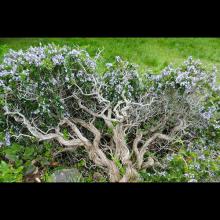Salvia rosmarinus
Common name:
Rosemary
Genus:
Salvia
Family:
Lamiaceae
Order:
Lamiales
Salvia rosmarinus
Common name:
Rosemary
Genus:
Salvia
Family:
Lamiaceae
Order:
Lamiales
Salvia rosmarinus
Common name:
Rosemary
Genus:
Salvia
Family:
Lamiaceae
Order:
Lamiales
Genus (Plantae): Salvia
Salvia is the largest genus of plants in the sage family Lamiaceae, with nearly 1000 species of shrubs, herbaceous perennials, and annuals. Within the Lamiaceae, Salvia is part of the tribe Mentheae within the subfamily Nepetoideae. One of several genera commonly referred to as sage, it includes two widely used herbs, Salvia officinalis (common sage, or just "sage") and Salvia rosmarinus (rosemary, formerly Rosmarinus officinalis).
The genus is distributed throughout the Old World and the Americas (over 900 total species), with three distinct regions of diversity: Central America and South America (approx. 600 species); Central Asia and the Mediterranean (250 species); Eastern Asia (90 species).
Etymology
The name Salvia ("salviya") derives from the Latin salvere ("to feel well and healthy, health, heal"), the verb related to salus (health, well-being, prosperity or salvation), referring to the herb's healing properties. Pliny the Elder was the first author known to describe a plant called "Salvia" by the Romans, likely describing the type species for the genus Salvia, Salvia officinalis.
The common modern English name sage derives from Middle English sawge, which was borrowed from Old French sauge, and like the botanical name, stems from Latin salvere. When used without modifiers, the name 'sage' generally refers to Salvia officinalis ("common sage" or "culinary sage"); however, it is used with modifiers to refer to any member of the genus. The ornamental species are commonly referred to by their genus name Salvia.
Description
Salvia species include annual, biennial, or perennial herbaceous plants, along with woody subshrubs. The stems are typically angled like other members in Lamiaceae. The leaves are typically entire, but sometimes toothed or pinnately divided. The flowering stems bear small bracts, dissimilar to the basal leaves—in some species the bracts are ornamental and showy.
The flowers are produced in racemes or panicles, and generally produce a showy display with flower colors ranging from blue to red, with white and yellow less common. The calyx is normally tubular or bell shaped, without bearded throats, and divided into two parts or lips, the upper lip entire or three-toothed, the lower two-cleft. The corollas are often claw shaped and are two-lipped. The upper lip is usually entire or three-toothed. The lower lip typically has two lobes. The stamens are reduced to two short structures with anthers two-celled, the upper cell fertile, and the lower imperfect. The flower styles are two-cleft. The fruits are smooth ovoid or oblong nutlets and in many species they have a mucilaginous coating.
Many members of Salvia have trichomes (hairs) growing on the leaves, stems and flowers, which help to reduce water loss in some species. Sometimes the hairs are glandular and secrete volatile oils that typically give a distinct aroma to the plant. When the hairs are rubbed or brushed, some of the oil-bearing cells are ruptured, releasing the oil. This often results in the plant being unattractive to grazing animals and some insects.
Reference: Wikipedia

